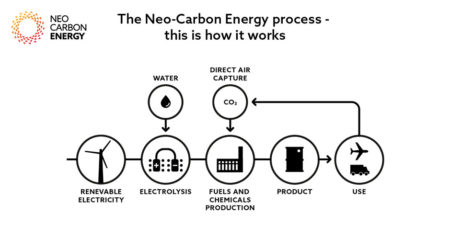Jun
28
Making Synthetic Fuels From the Air
June 28, 2017 | 4 Comments
The project is built on carbon dioxide capture, water electrolysis and subsequent synthesis units such as methanation for methane and Fischer-Tropsch for liquid fuels. It depends on very low cost renewable electricity based on wind and solar, and produces synthetic fuels in a carbon neutral way. This could lead to a whole new circular carbon economy.

The Neo-Carbon Energy Research Project and Technology enables the production of synthetic fuels straight from the air. Image Credit: Lappeenranta University of Technology. Click image for the largest view.
The cost estimates for producing liquid fuels with the project are around $140/bbl (0.80 €/l) between 2030 and 2040, if produced in the Maghreb region. Such prices were reached for crude oil in 2008. The cost could be even less in the future, due to declining solar PV and battery costs. The potential production volumes are practically unlimited, since Earth receives more than 1000 times more energy from the sun than it is used globally for all energy needs today. It is likely that Power-to-Fuels and Chemicals technology will gain increasing importance between 2030 to 2040.
Professor Christian Breyer for solar economy at LUT said, “A net zero emission economy without this technology is practically impossible.”
The raw materials needed in the process are carbon dioxide and water, with CO2 separated from the air. Hydrogen is generated from water by means of electrolysis. Electricity consumed in the electrolysis is supplied from renewables. Finally, CO2 and hydrogen are combined to form hydrocarbons in a synthesis reactor operated at high pressure and temperature. A future improvement might be to also use water from the air, which is a byproduct of the CO2 separation from air.
VTT’s Principal Scientist Pasi Vainikka said, “All technologies are known, most of them for decades.”
Neo-Carbon Energy is feasible in areas where renewable electricity is available at a low cost. Research shows that the most cost-efficient sites for producing hydrocarbons from the air are regions with abundant solar and wind resources, such as Patagonia, the Maghreb, the Horn of Africa or Western Australia.
The Middle East region is also well suited for production. The products are globally tradable as of today. Additionally, the liquids and chemicals need refining, which indicates parts of the existing global fossil oil value chain could remain after some restructuring. A new pilot plant will be opened in Finland in June.
One might think the Fins are shopping the OPEC countries for research support. The press release starts with an strong opening for OPEC losing petroleum fuel market share. “This could be a key asset in phasing out fossil fuels after the Paris Agreement, while also keeping some of the existing oil industry value chain intact.”
“The Paris Agreement requires a transition to a net zero emission world within a few decades. This means a full phase out of all fossil fuels. Yet, hydrocarbons are still necessary for sectors such as marine and aviation, as well as the chemical industry.”
One must credit the Fins for an admirable humanitarian perspective. Its hard to imagine helping the OPEC countries along when they range from nations lazily drifting through wealth, or seeking to destroy their customers’ economies with terrorism to scavenging through starvation from socialism.
But its a worthwhile effort, there are some long range minds in OPEC countries and the prospects of investment from the independent oil producing companies isn’t exactly high. One day the technology will have real potential and that’s when the private industry will look and likely push it along. For now oil is about $100 a barrel under the record high. This tech, as welcome as it is – is going to take a while.
Comments
4 Comments so far


project is built on carbon dioxide capture, water electrolysis and subsequent synthesis units such as methanation for methane and Fischer-Tropsch for liquid fuels. It depends on very low cost renewable electricity based on wind and solar, and produces synthetic fuels in a carbon neutral way. This could lead to a whole new circular carbon economy.
Note in the excerpt above the writer says it depends on cheap electricity…and specifically mentions solar. Industrial production would insist on a large facility to produce fuels with such a process, and would run it 24 hrs. Molten Salt Rx better and cheaper than renewables.
JP is right. Yet the business of research needs a bit of imagination and dreamer to even start. So sometimes there is a bit more dream than reality or simply some of the reality seems missing.
Wonderful! this article mainly talked about that how to make renewable energy and fuel. Utilizing waste to produce charcoal, tar and wood vinegar is a hot trend in today’s world, especially the biomass charcoal making machine project.
Making synthetic fuels from the air is great idea to make renewable energy.